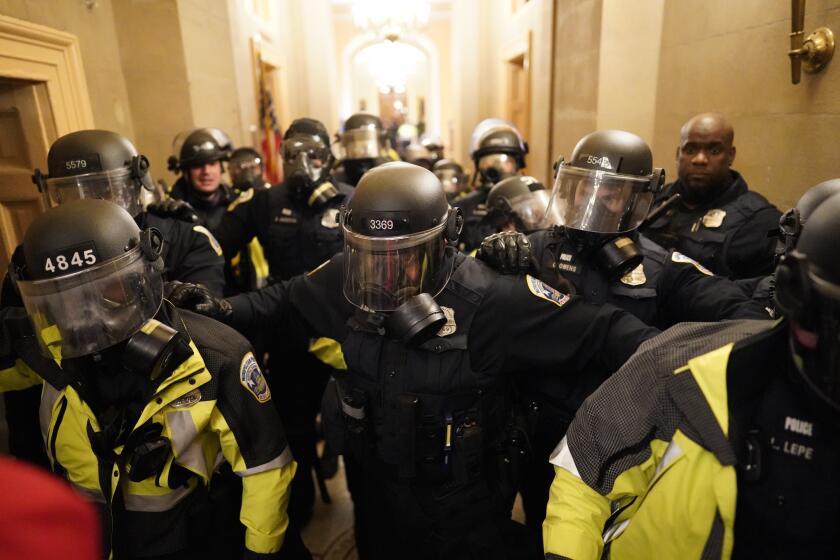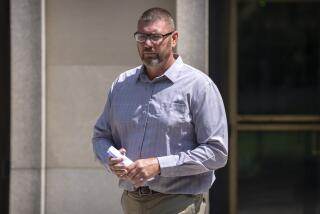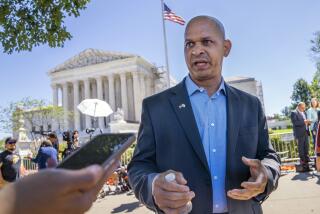Trauma in House gallery bonds members of Congress even a year later
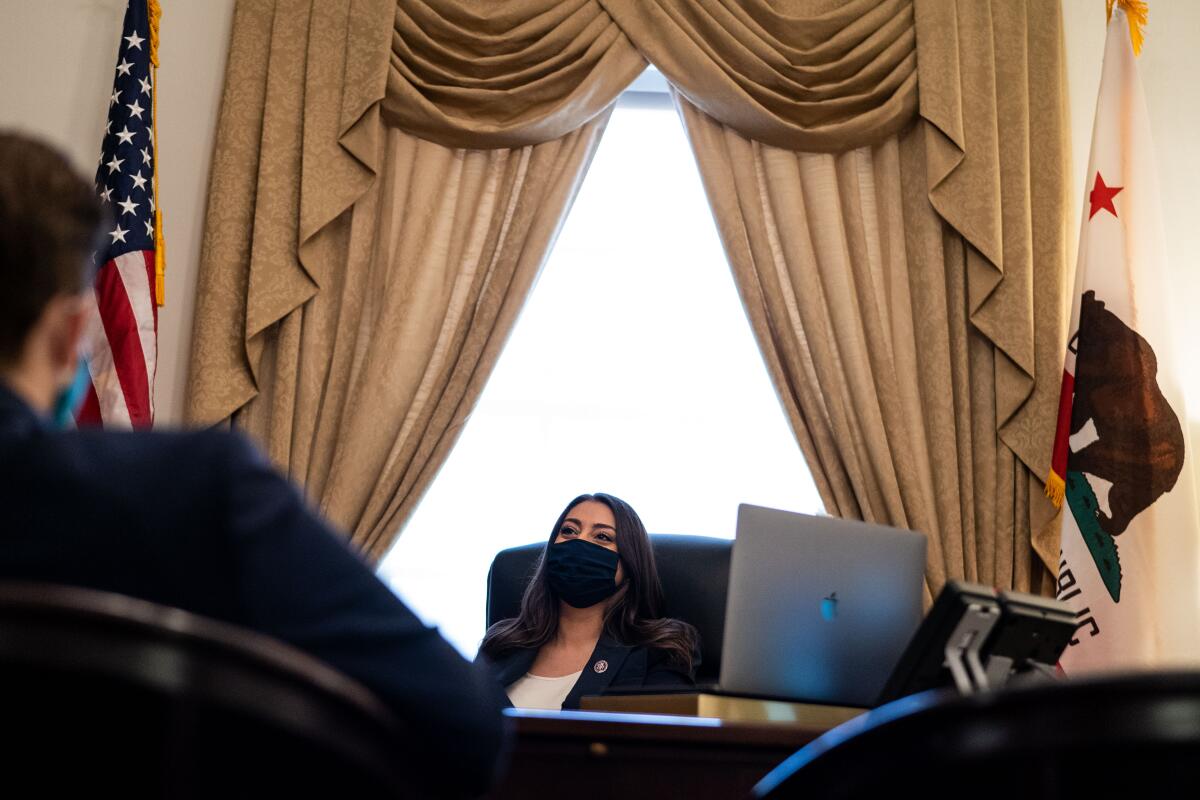
- Share via
WASHINGTON — A few months after a mob stormed the U.S. Capitol, Rep. Sara Jacobs was jolted back to one of the most terrifying moments in her life by a sound: the echoing thud of the doors to the cavernous House chamber slamming shut.
The Democrat from San Diego knew it was just a drill, but the moment nevertheless transported her back to the afternoon of Jan. 6, 2021, when she found herself trapped in the chamber’s gallery as a pro-Trump mob breached the building.
This time, the rookie lawmaker pulled out her phone and texted for help — from a support group of 28 House members who are wrestling with the same lingering trauma of having been cornered in the gallery that deadly day a year ago. In minutes, members flooded the chat group with responses that sought to soothe Jacobs’ anxieties.
“When they started closing all the doors and locking them, the sounds were very similar,” said Jacobs.
“It was very triggering,” she said, “and I really leaned on the group after that.”
The fallout from the training exercise was just one of many moments in the year since the insurrection when the “Gallery Group,” as it became known to its participants, has rallied around a struggling member.
Interviews with several of its participants, who discussed their involvement in broad terms to protect one another’s privacy, reveal how the diverse group of Democrats formed a tight and intimate bond as they navigated the unsettling experience of having survived a violent insurrection.
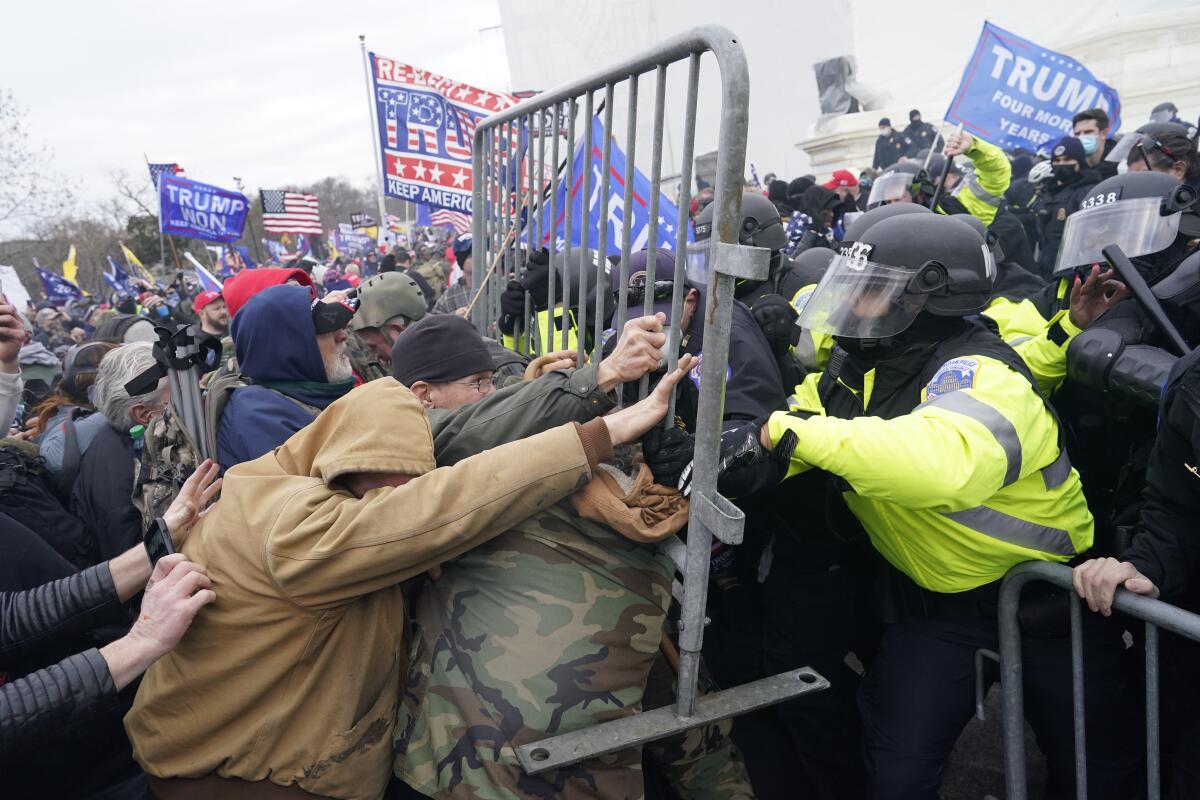
They have supported one another through the immediate shock of the day, the impeachment of then-President Trump over his role inciting the mob, the release of haunting videos of the violence, the continuation of the false narrative that Trump won the election and simmering tension between Democrats and the Republicans who continue to perpetuate that myth. With the memory-laden and stress-filled anniversary approaching on Thursday, lawmakers say the Gallery Group is proving to be their go-to lifeline.
During the Jan. 6 Capitol riot, six Congress members from California hid, fled or watched as a pro-Trump mob attacked. They look back and discuss what’s changed.
“It was a really traumatic experience that at the same time was hyper-personal and hyper-national,” said Jacobs, one of two freshmen in the group who was so new to her job on Jan. 6 — her fourth day in office — that she says she was “hiding under a chair, introducing myself to people.”
“Having other people who went through it was really, really important for me,” she added, “as I was processing what happened and how to think about it and how to maintain resilience around it.”
A bond formed in trauma
When the mob breached the Capitol, the majority of the 435 House members were in their offices in the surrounding buildings, or on the House floor. Capitol Police quickly cleared the House floor and ushered those lawmakers into a safe room. But for the 30 or so lawmakers in the gallery — all Democrats, according to members — there was no such quick rescue.
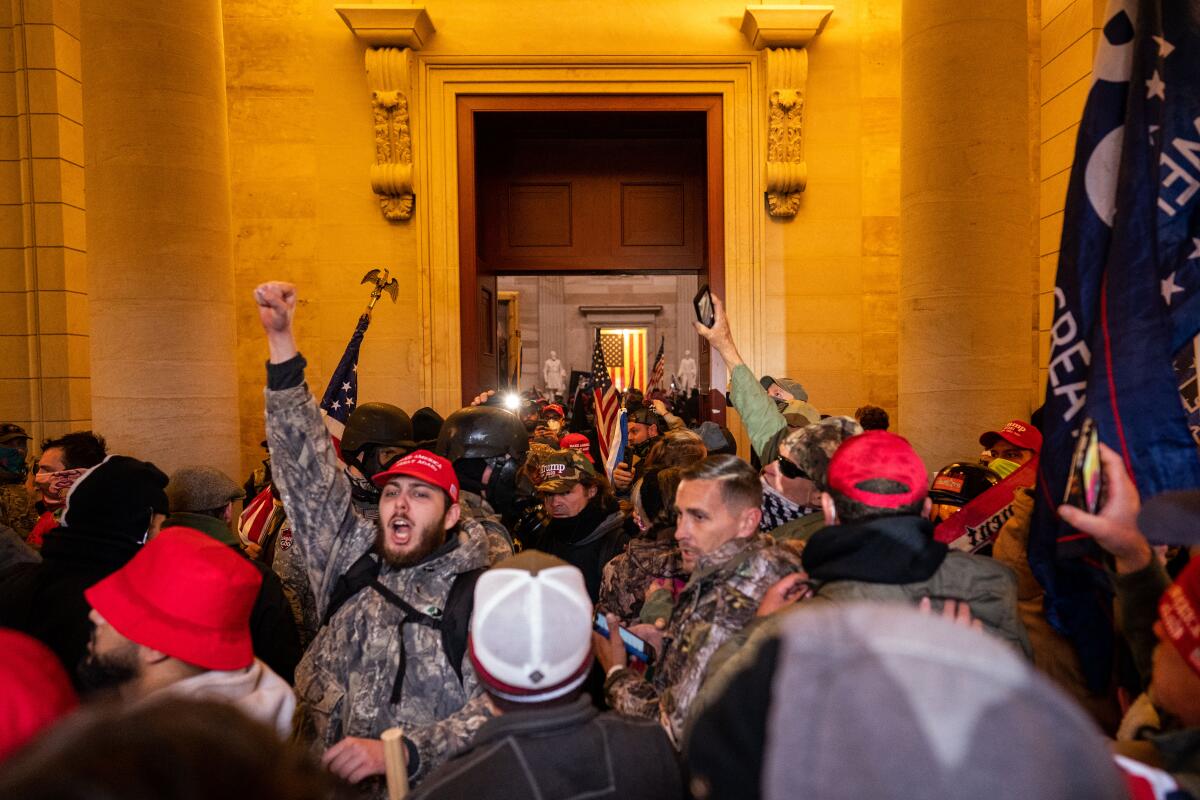
Rioters had swarmed into the building quickly, before the gallery could be evacuated. The best police could do was to lock the doors and tell lawmakers to hunker down, according to members’ accounts.
As they looked over the balcony’s railing and watched their colleagues being whisked away to safety, they felt trapped. Some contemplated jumping but reconsidered — it was too steep a drop.
They watched police barricade the chamber’s door and hold back the insurgents, who had broken a glass window into the chamber. They heard the mob approaching in the nearby hallways and the gunshot that killed Ashli Babbitt, a rioter who broke through a blocked hallway and was slain by a Capitol Police officer guarding lawmakers. They prayed with Rep. Lisa Blunt Rochester of Delaware and followed Arizona Rep. Ruben Gallego’s instructions on how to put on a gas mask.
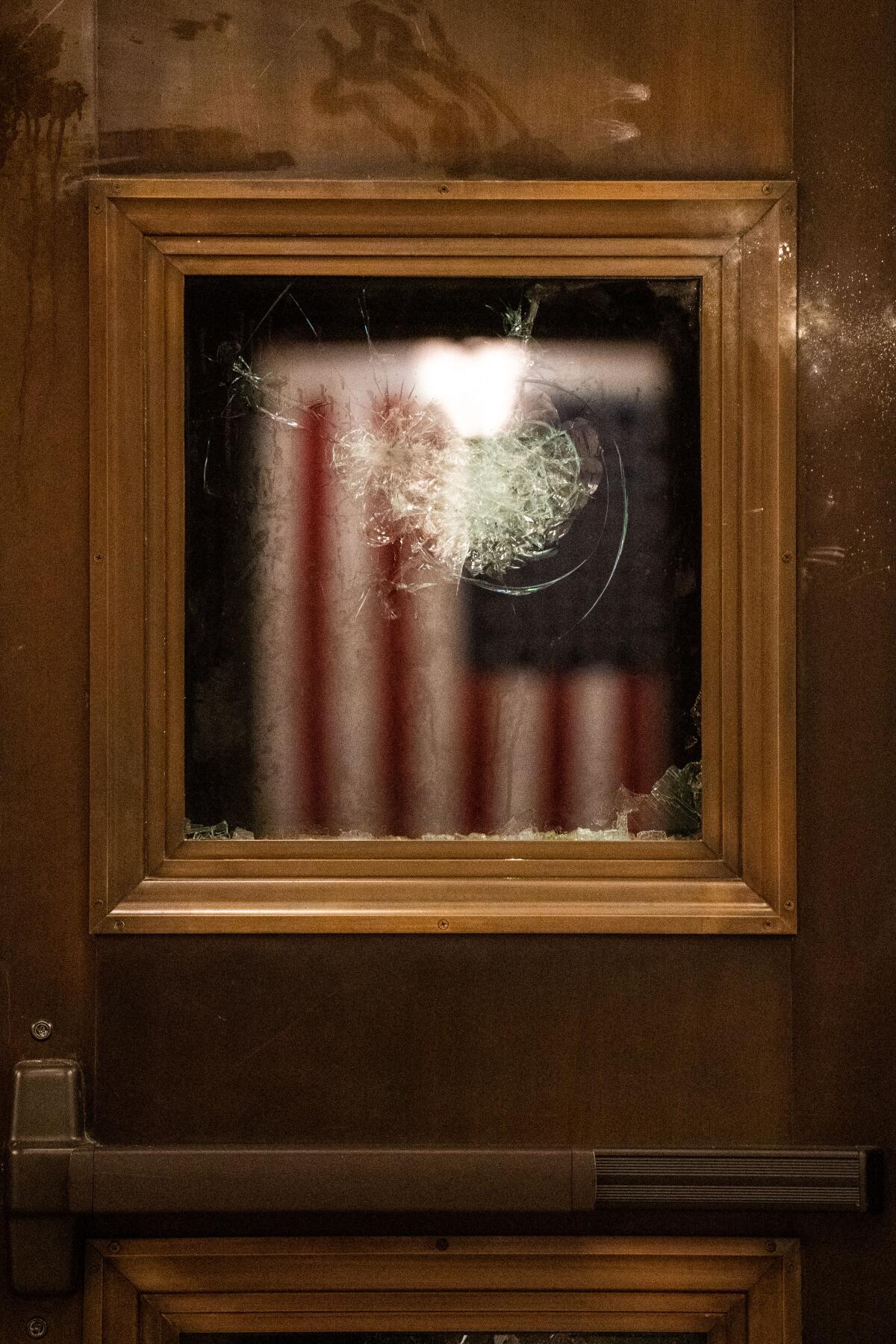
“We and a couple of other groups of people — we were left behind,” said Rep. Dan Kildee of Michigan. “There was no way to go out the back way. There was no way down to the floor. So we were just totally stuck. That experience was really traumatic for us.”
In under an hour, according to members’ accounts, police cleared the hallway of rioters enough to escort members to a safe room, where they reunited with their Republican and Democratic colleagues. (All of the members in the gallery had been Democrats because they were adhering to COVID-19 safety protocols and Republicans were not, according to Democrats.)
A few days after the attack, during a virtual meeting among House Democrats, Rep. Pramila Jayapal of Washington state discussed the horror of what she and the others in the gallery had faced.
She expressed concern that other members were grappling with it all, too. So, she started a text chain:
“Thanks to all who reached out to me after I spoke today about our experiences as the group in the gallery on the 6th, experiences that are quite different from other members who were on the floor or in their offices since we got left there for at least 45 minutes after everyone else was evacuated. I know many of you are experiencing similar feelings of trauma and stress,” Jayapal wrote, including details for a virtual meeting to be held on Zoom a few days later.
“This is just for anyone who wants/needs it, of course,” she added, “so if you don’t feel like you want to participate, no pressure at all. Love to you all. Be gentle on yourselves.”
‘Instantaneous trust’
The Gallery Group quickly became more than a text chain. The first Zoom meeting, moderated by Jayapal, lasted for hours.
“It was an intense day where people really shared very deeply about the experience, about their own personal experiences [with other trauma] — in some cases sexual assault, and in some cases taking them back to their military service,” Jayapal said.
“There were a lot of fears. There was a lot of intimacy that you don’t typically get as members of Congress,” she said. “But it was the bond of that experience that created almost instantaneous trust that people were willing to be open and share.”

Like others, Kildee struggled with what he was sure was post-traumatic stress disorder. He sought out a Washington-based trauma psychiatrist, Jim Gordon, who has since met with the group as well as with Capitol Police officers, as both groups deal often with reminders of the day.
Rep. Jimmy Gomez noticed the effects days later and hundreds of miles away, once he was back home in Los Angeles. “I kept on snapping. I would snap at my wife ... lose my temper over nothing,” he said.
The lawmakers, over several sessions, learned to identify triggers and symptoms of PTSD and how to manage them. Their sessions led to frank discussions about a variety of topics, including poignant reflections about race.
They talked about the decision some members made during the riot to remove the small pin they wear that identifies them as members of Congress. Fearful of the mob entering the chamber, several men removed their pins or took off their suit jackets in hopes of not being identified as lawmakers. Rep. Dean Phillips (D-Minn.) disclosed that he considered trying to blend in with Republicans.
But the women of color who were in the gallery said those were not options for them; both the House GOP and the pro-Trump mob were mostly white. Some didn’t remove their member pins — they thought their chances were better if Capitol Police officers were able to identify them as members of Congress.
It was a fraught discussion, highlighting how even those in the same spot faced different dangers.
Phillips “realized in the conversation about race that he was a white man and he could do that — that he could hide his identity — and that for many of us, we couldn’t,” Jayapal said. “There were many powerful moments like that.”
A spectrum of Democrats
The Gallery Group evolved into a constant presence for some lawmakers. Soon they were meeting for in-person dinners and “friendsgiving.” The text chain, which moved to the encrypted app Signal, became a place where members discussed the news surrounding Jan. 6 and internal House Democratic politics, but also swapped recipes and photos of their children or grandchildren.
“It runs the whole gamut,” Rep. Abigail Spanberger of Virginia said. “Just very, very simply, it’s a group of people who I think trust each other in a particular way.”
Congress is filled with subgroups of the Democratic caucus — progressives, centrists and state delegations — that meet and socialize regularly. But none has established bonds that run as deep as those in the Gallery Group, its members say.
“What was so interesting for me about the strengthened friendships that we formed as a result of this shared negative experience is that it brought a significant amount of humanity right to the core” of our work, Spanberger said.
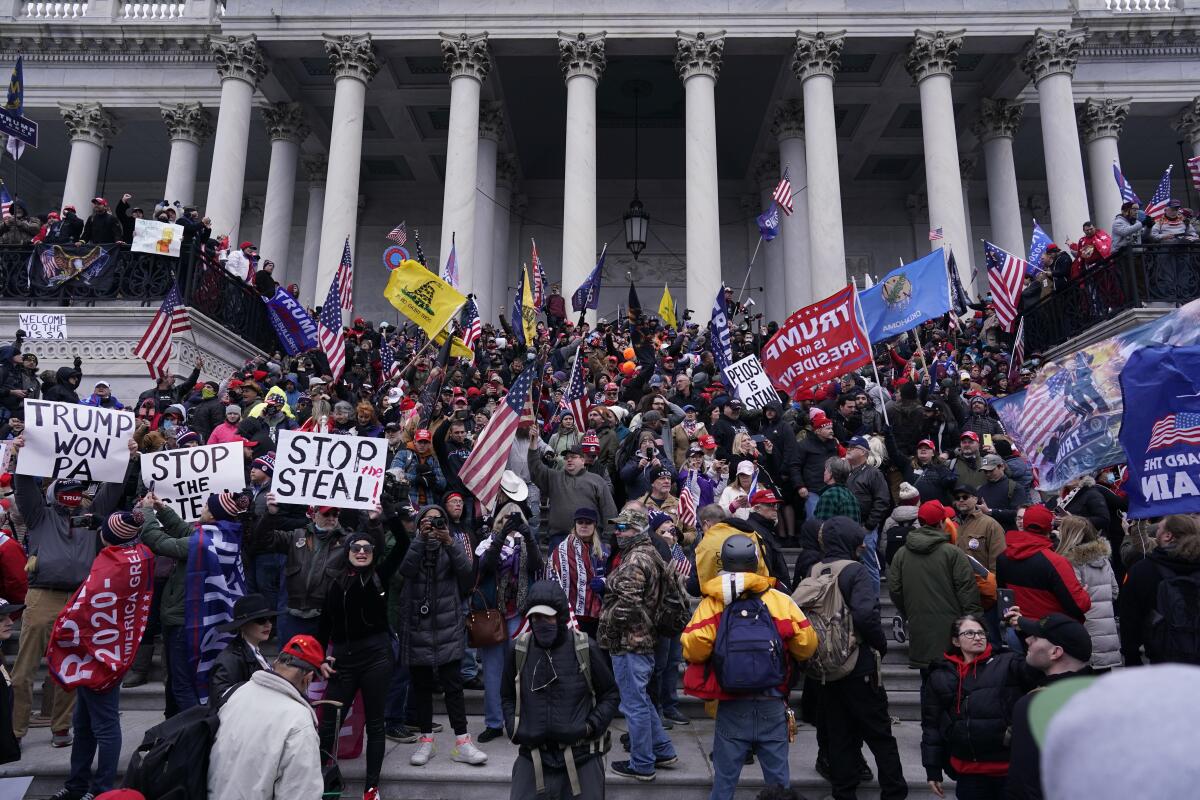
Members say the group would be unlikely to work if Republicans were in it, given the mistrust between the parties and the country’s deep polarization. Democrats say they could not be as honest about processing their anger at so many Republicans for supporting the election lie that led to the riot.
“It would not be possible given the kinds of conversations we’re having,” Jayapal said.
The anniversary
Anticipation of the one-year anniversary has loomed large in the group’s thoughts in recent weeks. Last month, Gomez had a lengthy recorded discussion on the insurrection that left him feeling at sea.
“I was just not in a good mood afterwards. I texted the Gallery Group,” he said. “You can basically tell them, ‘Oh, I felt it today,’ or ‘I got triggered today.’ And people understand.”
Gomez says he feels compelled to continue to talk about the horror of Jan. 6, “but it’s not easy. It’s not easy for us to talk about.”
For Kildee, the trigger is walking through Statuary Hall or the Rotunda, which were littered with debris the evening of the attack — that was when he truly realized how big the mob had been.
“I just can’t get out of my mind what I saw that night,” he said.
Suspecting that Gallery Group members might need some help as they are increasingly confronted by reminders of the events of a year ago, Kildee scheduled a group meeting with Gordon, the therapist.
The group has debated how Congress should mark the riot’s anniversary on Thursday in the face of some Republican lawmakers and Trump downplaying the attack.
Some say they need to make a stand and commemorate the riot on Capitol Hill. Others, like Spanberger, have expressed concern that their presence at the Capitol will only increase the demands on Capitol Police officers, who suffered so many injuries and traumas of their own. Some have considered staying home, away from triggers in Washington.
Regardless of their locations, chances are they will all be in the Gallery Group, texting away.
More to Read
Get the L.A. Times Politics newsletter
Deeply reported insights into legislation, politics and policy from Sacramento, Washington and beyond. In your inbox twice per week.
You may occasionally receive promotional content from the Los Angeles Times.
